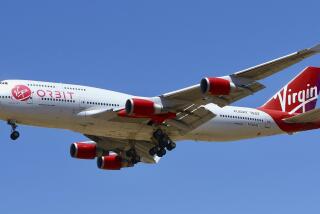Challenger Disaster Touches Workers at Teledyne Unit : Satellite Systems Were Ready to Go
- Share via
Although Teledyne Systems did not have any equipment on the space shuttle Challenger when the craft exploded Jan. 28, the Northridge-based company is feeling repercussions from the tragedy.
The company’s so-called “black box” guidance systems were ready for two satellites that were scheduled to be launched from shuttle flights in May--flights that have been postponed by NASA until June, 1987.
Teledyne Systems has been paid for that equipment but it will lose out on service fees, at least for another year, and other potential shuttle business has been put on hold.
But the pain at the company, one of hundreds of contractors that make equipment for the shuttle, is mostly psychological. Company officials say morale sank after the accident.
“We’ve all been deeply shocked and saddened by the explosion,” said Teledyne Systems President Harry Halamandaris, who was at Cape Canaveral for the Challenger launch in January.
Teledyne Systems, which has annual sales of about $150 million--double that of four years ago--makes computers and software. Its products include the intricate packages of hardware and software that direct communications satellite antennas, guide rockets and satellites into space and send fighter jets toward their targets.
Founded 25 years ago, the Northridge operation was the starting point for Teledyne, the Los Angeles-based defense firm that reported sales last year of nearly $3.3 billion. Teledyne has 135 subsidiaries.
Teledyne’s products are diverse. They include corrosion-resistant metals and diesel engines used in military tanks and in heavy construction equipment.
Teledyne Systems isn’t the only unit of the company that works on the space shuttle program. Other Teledyne subsidiaries make movie cameras that travel on the shuttle as well as wire and cable for the craft.
Nearly 25% of Teledyne Systems’ revenue comes from space projects, Halamandaris said. About 60% comes from equipment for jets and helicopters; the rest comes from making calibration devices and computerized military-training equipment.
Classified projects account for 10% of sales.
Teledyne Systems runs in fast company. Its competition includes IBM, Delco Electronics, Litton Industries, Westinghouse, Honeywell and RCA. Half the company’s orders come directly from the military; the rest are from prime contractors such as General Dynamics, Grumman, Northrop corporations and Boeing Co.
In Northridge, Teledyne Systems has 1,700 workers, a third of them engineers and another third in manufacturing and quality control. Other employees are in administrative and support jobs.
Under Technological Gun
Halamandaris, 48, president since 1980, said the company’s biggest challenge is meeting constant pressure to develop new technology. “We need to have a new computer design for each of our projects every two years just to keep up,” he said.
Teledyne Systems’ contribution to the spring space shuttle missions was to make the controlling computer, or the electronic brains, for the Centaur launch vehicle. Teledyne Systems has made the computer for the Centaur, the second-stage rocket that sends military satellites and planetary probes into space, since 1969.
In the past, Centaur rockets have been launched from first-stage vehicles, such as Atlas or Titan rockets, that take off from the ground. But in the May missions, the rockets were to be released by a spring mechanism from the shuttle’s cargo bay.
The plan was for the Centaur rocket to fire its engines when it was safely away from the shuttle and then send the Ulysses exploration probe toward the sun. In the later mission, a similar probe, the Galileo, was to be thrust toward Jupiter.
The black box Teledyne Systems produces for the launch vehicle makes sure the rocket sends the probes in the right direction.
The Ulysses and Galileo missions cannot be rescheduled until next year, partly because the preferred alignment of the Earth, sun and Jupiter will not occur again until then.
The shuttle disaster, however, represented more than an inconvenience for Teledyne Systems--it also prompted some soul-searching among employees.
Saul D. Bass, a Teledyne Systems vice president, said the loss of life raised the question of whether the United States should “keep using people to achieve things that machines can do with less at risk.”
More to Read
Inside the business of entertainment
The Wide Shot brings you news, analysis and insights on everything from streaming wars to production — and what it all means for the future.
You may occasionally receive promotional content from the Los Angeles Times.








